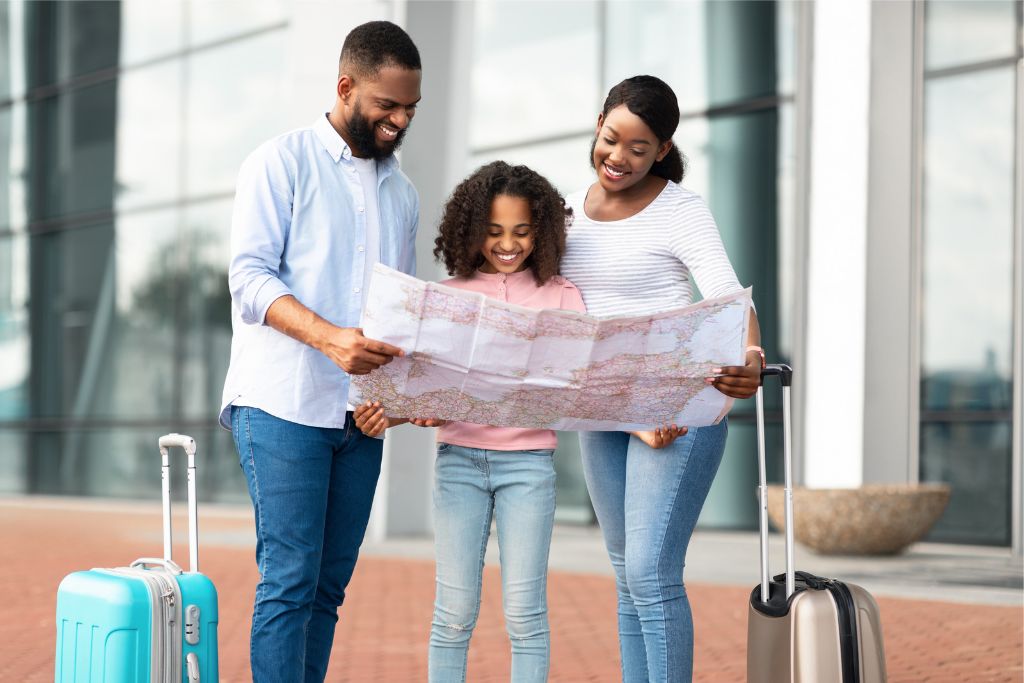Traveling With Kids – 5 Tips to Help You Plan
If you’ve never taken long trips with your kids because you were nervous about how they (or you) might handle it, then I have some tips for you. Even if your kids are traveling pros, you should still keep reading to see if you find any new ideas to make your travels even smoother. And then, make sure you share some of your earned wisdom with the rest of us in the comments below this article. We can all use more tips and ideas to make vacations more pleasurable.
Traveling with kids doesn’t have to be a stressful experience. With the right planning, preparation, and involvement, everyone can relax and enjoy a long trip.
My kids and I have been taking long trips during the summer since they were 3 and 1. And traveling does get easier as kids grow. But at the same time, I think they learn to be experienced travelers only by practicing. And long, eleven-hour flights were already enjoyable with my kids by the time they were 6 and 4.
The secret to a successful trip with kids lies in thorough preparation. So let’s get into it.
[Disclosure: The following article may contain affiliate links, which means I earn a small commission, at no extra cost to you, if you make a purchase using the links below. Please read my affiliate disclaimer for more information. Your purchase using the links below supports the creation of new content on this website.]
Table of Contents
1. Learn about the destination
Starting a few weeks before the trip, you can add the destination city to your weather app and, together with your kids, check and compare the weather at your destination and your hometown daily. Not only do kids love to learn these things, but getting a sense of the weather can help with packing the right clothes for the trip.
Another way to learn about the destination is to look it up online. Most countries and cities have a website where you can learn about the local culture and find recommendations for things to do in the area. This can be a great opportunity to teach your kids how to research a travel destination. As you are reading, you can make a list of things you would like to do and places you would like to see while you’re there.
If your kids are older than 9, you can also locate the interest spots on Google Maps, then save them in a special list. This is a great way to show your kids how to use technology as a tool. And at the same time, you are creating a purpose for the trip.
2. Discuss details about the trip
We tend to think kids don’t care about or are too little to be involved in the planning of the trip. But when kids know what to expect, they feel calmer and more excited, as opposed to anxious and nervous.
You can look at the map with your kids and show them the itinerary. You can also talk with them about what they can expect during the trip: where and when you will be making stops, how long you will be staying there, where you will be spending the night, and so on. Walk them through the trip step by step to help them picture in their minds what will happen.
If your kids have never been on an airplane, it helps to read a book ahead of time so they know what to expect. Look for a fun book that shows the inside of an airport and the checkpoints you will be going through.
3. Pack with style
When my kids were between the ages of 3 and 7, they used their own Skip Hop suitcase on wheels. They were cute and just enough for little kids. When they turned 8, I got them each a bigger backpack, but you can also opt for a larger rolling backpack or carry-on bag on wheels. Kids love being involved in everything, so offer them a few choices and let them pick their favorite design.
You can also get them a matching water bottle for the trip but, even if it’s not matching, it’s fun to have a new one. Also, kids tend to drink more and stay hydrated if they are excited about a new bottle.
In their little suitcase, you can help your kids pack the things they will be needing on the plane or car ride. Do not let them pack their suitcase alone. Take this opportunity to teach them to organize their bag. I recommend doing this in four stages.
Step 1- For kids aged 3-5 or when first teaching them how to pack
In the beginning, you will have to do most of the work, but make sure to involve them and explain your thinking so they can learn from what you are doing. You can put everything on the floor in categories. Then, while holding the bag, you ask your child to give each item that goes in. Then you show them how to place the individual bags inside the suitcase so they don’t have a hard time closing the zipper. Also, remember to not overfill the suitcase so they can close it easily.
Step 2 – For kids aged 6-7 or after packing for a couple of years
As kids grow older, you can sit with them, tell them what items to bring, and place them on the floor around the suitcase, just as you did when they were little. Then you remind them which items go in which bags and you can help them a little if they’re having trouble fitting things into the plastic bags in a neat fashion.
Step 3 – For kids aged 8-9 who have some experience packing
With older kids, you can sit there and watch them pack, while answering their questions or guiding them when needed. At this age AND with a few years of experience, kids are pretty capable packers. Notice that I wrote the word “and” in capital letters because kids can only reach this level if they’ve practiced packing for a few years. If your kids are just starting out, then start them at step one.
Step 4 – For kids 10 and older who are experienced packers
Then, with even older kids, you can leave them to pack by themselves, but check their suitcase or backpack to make sure they have everything or that they haven’t packed a lot of unnecessary items. You don’t want any surprises on the plane or car.
Don’t assume that, just because you packed the suitcase together last year, your kids will remember how to do it this year. Always remind them of the items they need to pack or ask them to list them to you. Have patience and walk them through every step and they will become excellent at it.
Notice that what you are doing here is releasing responsibility gradually, as your kids are gaining mastery. I know this method takes longer than leaving kids to pack by themselves or doing it for them, but this is a fool-proof method to teach kids to be independent and a fantastic opportunity to teach them so many life skills that will benefit them later.
What goes in the kids’ suitcase:
I like to organize everything into bags inside the suitcase/backpack. That way, when kids need anything, they can just pull out a bag instead of everything flowing out of the suitcase when they open it.
- A 2.5-gallon Hefty bag. In it, they put their books and toys for the flight or car ride. Once we are on the plane, they take out the whole bag and keep it at the bottom of their chair.
- The water bottle which they can fill after passing the security checkpoint at the airport.
- A gallon-size bag with a change of clothes: socks and underwear just in case and a long sleeve shirt and long pants if it gets chilly. In this bag, you can also pack a soft sleep mask so your kids can sleep on the plane or in the car.
- Headphones and a tablet, in case you want to let your kids have screen time during the trip. This is optional, of course.
- One or two plushies – put a limit on it and help your kids decide if they want to bring the whole menagerie with them.
Take the time to teach your kids how to stay organized by only taking out one activity or toy at a time, and putting it back in the bag when they’re done or before taking another one out.
4. Make the car ride or flight fun
Whenever we go on a long car ride or flight, I try to pack a few fun and interesting items. Kids love discovering a new toy, set of pencils, sketch pad, or activity book.
When I buy a new toy or game, I look for items that are small and light, have magnetic pieces, or are packed in a way that prevents pieces from rolling around and getting lost. Puzzles, fidget toys, and surprise bags are great options.
I prefer pencils over markers for younger kids, but older ones can be fine with handling markers and pens without getting them on their clothes or chairs. You know your kids best, so decide wisely. My kids love scented markers, sparkly pens, rainbow pencils, and other unique writing utensils that they don’t regularly use.
Younger kids love water pens and magic markers which don’t stain surfaces.
Activity books with mazes, hidden pictures, Mad Libs, crossword puzzles, sticker books, and decoder activities are all so much fun and can keep kids and adults engaged for long stretches of time. If your kids are into Minecraft, Pokemon, Disney, or any other characters, you can find activity books with the themes they love.
A new book to read with great pictures is also a good option for some quiet time on the road or flight.
For lots of ideas on what toys and games to pack for a long trip, for kids ages 2 to 10, check out this article:
Related: Engaging Travel Games for Young Kids
5. What about snacks
Especially if you are flying, it’s helpful to have some lollipops on hand for take-off and landing. But you don’t want your kids hyped up on sugar, so sugar-free lollipops not only save your kids’ teeth but also help relieve ear pressure.
Just because your kids are older, it doesn’t mean you have to avoid the toddler snack aisle. Kids love cookies and puffs that have interesting shapes and you can find snacks that are low in sugar and made from veggies and fruits in the baby and toddler section.
If you fly, you can’t bring any liquid foods, but if you are driving, yogurt or apple sauce pouches are a good idea.
5. Create memories
Buy a new and cute journal for each kid. I like one that has the top half unlined and the bottom lined. That way, the kids can draw and then write about the event they want to record in their journal.
When we travel, I encourage my kids to jot down something every day in their journal. Generally, they are too tired at the end of the day, so they do it the next morning when their minds are rested.
Here are some examples of prompts you can give your kids if they can’t come up with any ideas to write about:
- Make a list of things we did or saw.
- Write about one thing that you did or saw.
- What is something new you learned?
- What was really interesting/boring/exciting?
- What surprised you?
- What are some feelings you had? What made you feel that way?
Avoid asking kids to write about the most interesting, the most fun, the most anything. They may think they have to rank and pick the top activity and that can be overwhelming for some kids.
Remember that the point of a journal is to help us remember fun events. I know journaling helps with writing, but that shouldn’t be the focus here. Spelling mistakes are ok. The ideas are more important.
I hope that you have found these ideas helpful and that you will get to enjoy traveling with your kids a little more on your next trip. If you have more tips for us, please leave them in the comment section below. Have fun!







